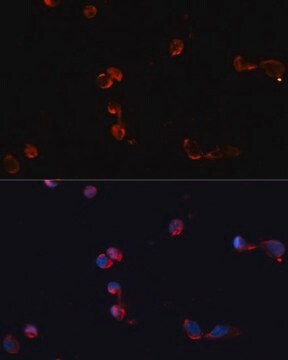C0979
Anti-Catalase antibody ,Mouse monoclonal
clone CAT-505, purified from hybridoma cell culture
Synonim(y):
Anty-CAT
About This Item
Polecane produkty
pochodzenie biologiczne
mouse
białko sprzężone
unconjugated
forma przeciwciała
purified from hybridoma cell culture
rodzaj przeciwciała
primary antibodies
klon
CAT-505, monoclonal
Formularz
buffered aqueous solution
masa cząsteczkowa
antigen 60 kDa
reaktywność gatunkowa
human, mouse, bovine, rat
stężenie
~2 mg/mL
metody
immunocytochemistry: suitable
immunohistochemistry: suitable
indirect ELISA: suitable
microarray: suitable
western blot: 0.5-1 μg/mL using a whole extract of HepG2 cells
izotyp
IgG1
numer dostępu UniProt
Warunki transportu
dry ice
temp. przechowywania
−20°C
docelowa modyfikacja potranslacyjna
unmodified
informacje o genach
human ... CAT(847)
mouse ... Cat(12359)
rat ... Cat(24248)
Opis ogólny
Immunogen
Zastosowanie
Western Blotting (5 papers)
- Immunocytochemistry
- Immunohistochemistry
- Indirect ELISA
- Microarray
- Western blotting at a concentration of 0.5-1μg/mL using whole extract of HepG2 cells
- Immunofluorescence
Działania biochem./fizjol.
Postać fizyczna
Uwaga dotycząca przygotowania
Oświadczenie o zrzeczeniu się odpowiedzialności
Nie możesz znaleźć właściwego produktu?
Wypróbuj nasz Narzędzie selektora produktów.
Kod klasy składowania
12 - Non Combustible Liquids
Klasa zagrożenia wodnego (WGK)
nwg
Temperatura zapłonu (°F)
Not applicable
Temperatura zapłonu (°C)
Not applicable
Wybierz jedną z najnowszych wersji:
Certyfikaty analizy (CoA)
Nie widzisz odpowiedniej wersji?
Jeśli potrzebujesz konkretnej wersji, możesz wyszukać konkretny certyfikat według numeru partii lub serii.
Masz już ten produkt?
Dokumenty związane z niedawno zakupionymi produktami zostały zamieszczone w Bibliotece dokumentów.
Klienci oglądali również te produkty
Nasz zespół naukowców ma doświadczenie we wszystkich obszarach badań, w tym w naukach przyrodniczych, materiałoznawstwie, syntezie chemicznej, chromatografii, analityce i wielu innych dziedzinach.
Skontaktuj się z zespołem ds. pomocy technicznej









